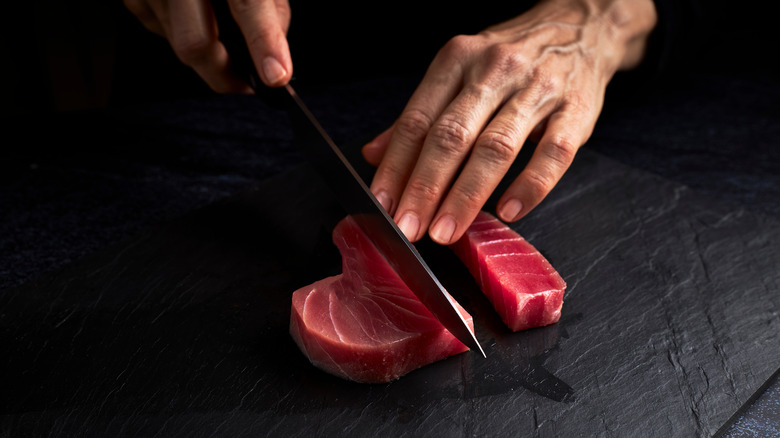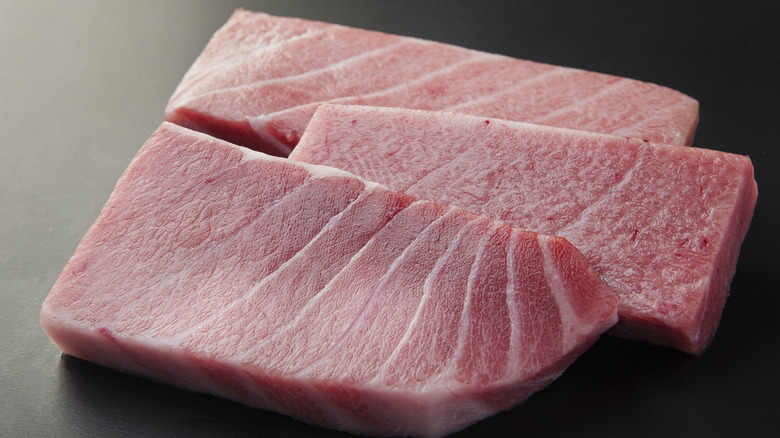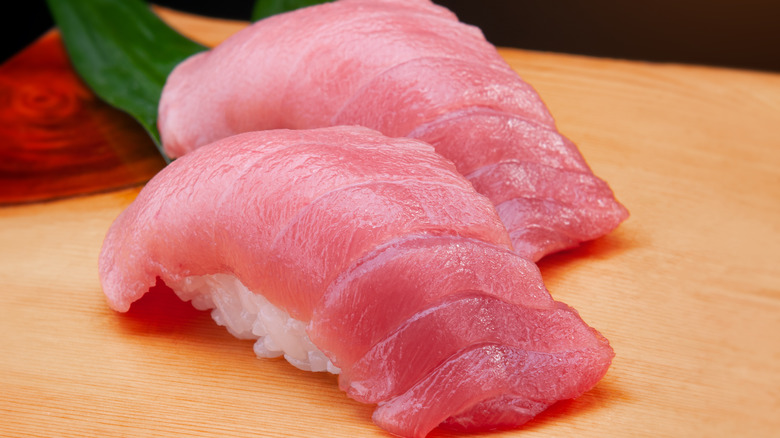The Fatty Difference Between Toro And Otoro Tuna
Once thought of as an inferior fish due largely to its size, which made it hard to preserve, tuna has undergone a renaissance in Japanese cuisine since the mid-20th century. Refrigeration helped fuel the increasing popularity of tuna, but so too did soy sauce, which allowed for marinades that better showed off its flavor. Today, tuna — called maguro in Japan — is a beloved staple of the nation's seafood-focused cuisine, and one frequently showcased in sashimi and sushi types such as nigiri, maki, and uramaki.
Although maguro is a catch-all term for tuna, there are actually eight different species of tuna, each with its own specific name in Japanese cuisine. Pacific bluefin, for example, is the most highly prized species of tuna and is known in Japanese as kuro-maguro or honmaguro, meaning "true tuna." Bigeye tuna, meanwhile, is known as mebachi-maguro, while yellowfin is called kihada-maguro, and albacore's moniker is bincho-maguro.
Because of its impressive size the Pacific bluefin tuna, for example, can weigh as much as 1,300 pounds. Several different anatomical parts of tuna are used in Japanese cuisine, with their desirability and price of individual cuts directly tied to their fat content. The more fatty a cut is, the more expensive it will be. And like the tuna types, each cut has its own distinct name.
What toro signifies in Japanese sushi
Each part of the maguro is named in Japan, with these labels serving as grades for the qualities of each specific cut. Akami, for example, is the most commonly seen cut of tuna — in sushi restaurants and supermarkets — and features the bright red color many people associate with the fish. Sourced from the upper back of the maguro, akami is leaner and less fatty than toro. For this reason, it's also cheaper.
Toro, meanwhile, refers to cuts sourced from the belly region of the tuna. These cuts are far rarer, since they come from a smaller area of the fish, and are renowned for their fattiness, smooth texture, and melty mouthfeel. It's important to note, however, that the term toro actually encompasses two different sub-types — otoro and chutoro. In contrast with akami's vivid red color, chutoro cuts are more of a pinkish hue. Otoro is even paler, appearing almost pinkish-white. Both toro cuts are used in sushi and sashimi, as well as in negitoro, a toro tuna paste often served with green onions.
Why otoro cuts are so expensive
Now the most expensive cut of the maguro, the otoro was essentially useless before the age of refrigeration due to how quickly it spoiled. These days, however, it is extremely sought after for its marbled fat, soft texture, and unusual sweetness. There is no fattier tuna cut than the otoro, which is often noted for its "melting" quality. Otoro is best spotlighted via sashimi, although of course it's a rarity.
The other toro grade cut, the chutoro, is also prized, but less so than the otoro — meaning it's not as expensive. This is due to its having a lower fat content than otoro, although it does outdo akami cuts in this regard. In fact, the "chu" in its name refers to this in-between status. This cut, like otoro, is often used for sashimi, but there is so little of it that only one sashimi of this type can be produced from each tuna.


